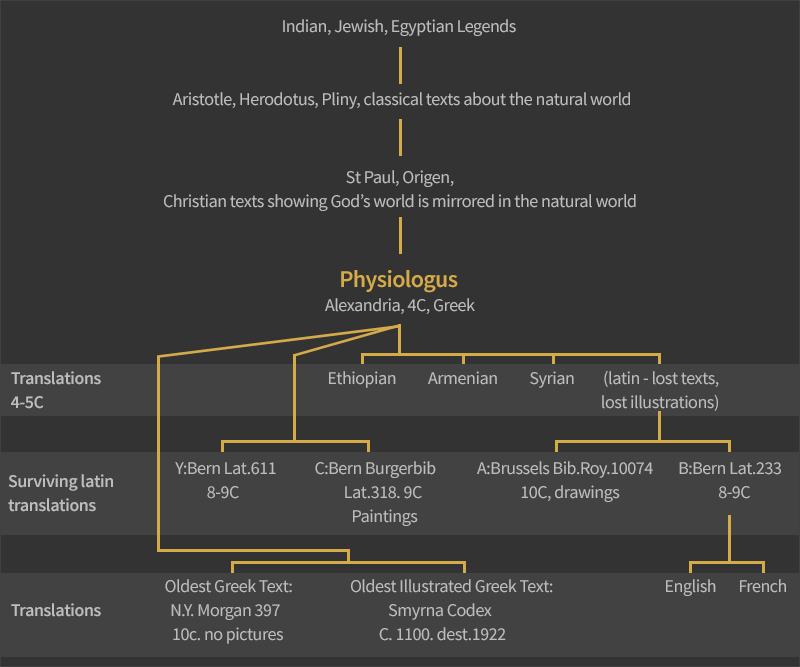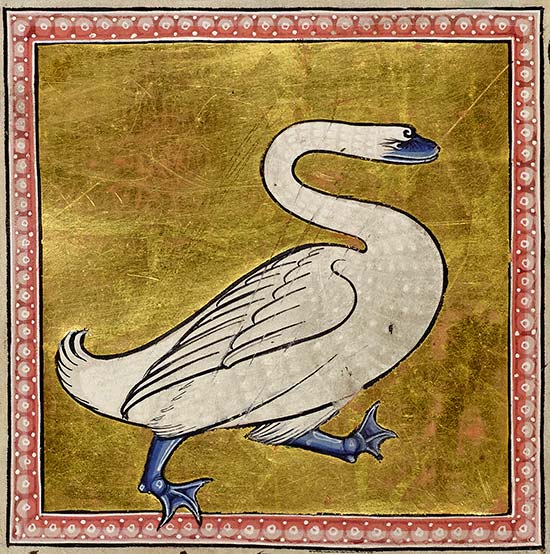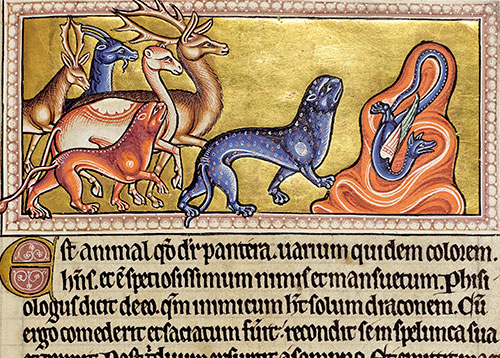A bestiary is a collection of short descriptions about all sorts of animals, real and imaginary, birds and even rocks, accompanied by a moralising explanation. Although it deals with the natural world it was never meant to be a scientific text and should not be read as such. Some observations may be quite accurate but they are given the same weight as totally fabulous accounts. The bestiary appeared in its present form in England in the twelfth century, as a compilation of many earlier sources, principally Physiologus. A great deal of its charm comes from the humour and imagination of the illustrations, painted partly for pleasure but justified as a didactic tool 'to improve the minds of ordinary people, in such a way that the soul will at least perceive physically things which it has difficulty grasping mentally: that what they have difficulty comprehending with their ears, they will perceive with their eyes' (Aberdeen MS 24, f25v).
The Origin of the Text
Physiologus was written in Greek, probably in Alexandria, in about the fourth century (Curley, 2009) . It consisted of around 50 chapters about beasts, birds and stones used as a vehicle for explaining Christian dogma. Its stories came from very ancient sources: Indian, Hebrew and Egyptian animal lore and various classical natural philosophers like Aristotle and Pliny. A moralising Christian gloss was added to these stories by a person presumably known as Physiologus. All the identifiable animals in this Alexandrian text (except for castor/beaver and antalops/the blackbuck) would have been known in north Africa. Animals from northern Europe only appear in much later texts. The accuracy of natural observation remains variable throughout, with many false statements (such as the swan's beautiful voice) repeated for centuries even where writers must have known the truth (George and Yapp, 1991).
No early Greek copies survive and the earliest surviving texts are Latin translations. They are the Y version (Bern, Lat. 611, 8-9th century), A version (Brussels, Bib. Roy. 10074, 10th century), C version (Bern, Burgerbibliothek, lat. 318, 9th century) and B version (Bern, Lat. 233, 8-9th century). The text of Y is very close to its Greek source but fell from use and had little influence on the other versions. The Brussels copy of A is important because it contains delicate Carolingian drawings to illustrate the text. C is a corrupt Greek translation, the Bern copy having the earliest painted illustrations. It is from the B version that the text of subsequent English and French Physiologus manuscripts derive, though none of this group is illustrated (McCulloch 1962, 21-25).
The earliest surviving Greek version of the text (New York, Morgan 397) was copied in the tenth century and has no illustrations. The earliest known illustrated Greek text, the Smyrna Codex, was made around 1100 but was burnt in 1922 (Strzygowski, 1899, 1-130; Demus, 1976, 235-257).


The Families of Text
No intermediate stages of development have survived between these Physiologus manuscripts and the bestiary proper which emerges in the twelfth century. The bestiaries use Physiologus as the core text but add increasing amounts of additional material from other books. The number of animals increases and so does the quantity of moralising comments. Studying their composition, M.R.James divided the bestiaries into four families. McCulloch and George and Yapp have subsequently subdivided the groups (James, 1928, 10-13; McCulloch, 1962, 25-44; George and Yapp 1991, xi-xiv, 1-5). The following is based on McCulloch and deals with the English manuscripts:
- The first family consists of the Physiologus plus extracts from the Etymologies of Isidore of Seville. Isidore, living in Spain in the seventh century, explained the true nature of animals by analysing their names. So, a cat is called catus because he catches mice. Isidore's encyclopedic work was not moralised. The sequence of chapters in the first family begins with Leo, Antalops and the animals are not classified. The earliest illustrated example of this group is Oxford Bod., Laud Misc. 247. An additional text, the Aviarium by Hugh of Fouilloy, begins to be used in some versions of this family, notably Oxford Bod. 602 and Douce 167. This book on birds was written after 1152 and excerpts were used in some bestiaries including Aberdeen and Ashmole. Hugh's text contains far more theology than the original Physiologus.
McCulloch identifies a Transitional group which keeps some of the chapters of the first family but adds large sections from Isidore and classifies the contents in the same way as Isidore, into Beasts, Birds, Fish and so on. Important illustrated Transitional manuscripts from the twelfth century are Camb., Trinity Coll. R.14.9(884); New York, Morgan 81; St Petersburg/Leningrad,State Public Library, MS Saltykov-Shchedrin Latin Qu.V.1; and B.L.Royal 12 C. xix. The Northumberland (formerly Alnwick) bestiary is mid-13th century. - The second family develops during the twelfth century, including 20 surviving English copies (Clark, 2006). The number of chapters have more than doubled to about 120 subjects. The additional material comes from:
- Isidore
- Solinus, Liber Memorabilium, a third-century travel guide, incorporating much of Pliny's Natural History
- Ambrose, Hexaemeron, a fourth-century commentary on the six days of creation
- and sometimes Rabanus Maurus, De Universo, moralisations added to Isidore's Etymologies.
- The third family appears in the thirteenth century, enlarged with Isidore's account of the Fabulous Nations, the Megacosmus by Bernard Silvestris. The sequence of beasts is altered, beginning with the domestic animals. There are only five known examples in this family, including the magnificent Westminster Abbey Bestiary (MS 22) (Baxter, 1998, 132-35).
- The fourth family is primarily based on De proprietatibus rerum by Bartholomeus Anglicus. Its only example is Camb. University Library Gg.6.5, from the fifteenth century.
The Sources of the Illustrations
Physiologus
In the same way that the text of the bestiary clings to earlier sources, its illustrations have a timeless, traditional quality. Their style evolves and reflects contemporary fashion but the iconography in many cases may derive from lost classical originals. The oldest illustrated Physiologus, the Latin ninth-century Bern 318, (Steiger and Homburger 1964) reveals its classical origins both in its composition and style. Most of the pictures are set in bold red frames neatly spaced between the text. Figures are set in a suggestive landscape and the paint is applied with a great feeling for space and light. This illusionistic manner of painting is typical of classical art and might imply that the artist had a classical model to work from. However in the ninth century, this classicising style had been so thoroughly absorbed by scriptoria particularly at Reims, that the artist might equally have used a contemporary model. There is evidence that the iconography of many of the Bern images must come from much earlier Greek sources. The earliest surviving Greek illuminated Physiologus (Milan, Bib. Ambrosiana MS E.16 sup, 11th century) shares several images such as serra, the pearl fishers and cervus with Bern 318, indicating that they must both derive from an earlier Greek source. The longevity of these scenes is demonstrated by fifteenth- and sisteenth-century Cretan copies which also share features like the half-human, half-snake viper with Bern 318. (These are Vatican Ottob. gr. 354, f26 and Vatican Barb. gr 438, f43. Muratova, 1984b, 387) Classical originals may have come from zoological texts , hunting and aquatic scenes, paintings of animals charmed by Orpheus, and still life compositions . Some of these can be found in manuscripts, wall paintings and mosaics.
The Brussels Physiologus has illustrations which are also classicising but derive mainly from a separate original cycle. These pictures, which are unframed lightly coloured drawings, have a narrative element and include symbolic, moral and allegorical themes. The only known Greek Physiologus with moralising illuminations was the Smyrna Codex (Demus, 1976, 235-257) whose animals correspond to those in the Latin manuscripts but whose allegories differ from the Brussels text.
The Sources of Bestiary Illustrations
There must have been illustrated copies of Physiologus in England from which the bestiary developed in the twelfth century. (There were unillustrated copies of Physiologus written in Anglo-Saxon: Cook ,1919). How or when they got here is not known. However the subject matter may have been of interest for a long time. Among the many books brought to Wearmouth from Rome or Gaul by Benedict Biscop in the eighth century was a Codex cosmographorum mirandi operis. This could have been a manuscript like the Etymologies of Isidore. At Peterborough Abbey in the eleventh century there was a Liber bestiarum given by Aethelwold, Bishop of Winchester around 984. Aethelwold, while abbot of Abingdon, stayed some time at the abbey of Fleury in France. He clearly showed some interest in the manuscripts there because traits of the Fleury scriptorium begin to appear in Winchester books at the end of the tenth century (Muratova, 1984b, 391-2. Goldschmidt 1947) Furthermore, the Bern Physiologus was at Fleury at that period, brought there by Archbishop Ebbo of Reims. The scriptorium at Fleury, an influential centre for diffusing classical heritage in the tenth century, could well have provided the link between the continental and English copies of Physiologus.
There is a gap between the production of Physiologus illustrations and the appearance of the earliest illustrated bestiary, Oxford, Bod. 247 in the early twelfth century. The delightful pen drawings of this book are so precisely laid out and delineated that they must be copied from an earlier model (Kauffmann, 1975, 75-6). The book shows the Physiologus and Isidore passages clearly integrated in a visual unity. Some images derive from the Bern and Brussels Physiologus, while others come from an unknown source.
The Lost Isidore Cycles
There are no surviving, early illustrated texts of Isidore's Etymologiae but the smooth fusion of Physiologus and Isidore images in the early bestiaries indicates that there must have been an early Isidore cycle. In the Aberdeen and Ashmole Bestiaries there is a seated portrait of Isidore at work. This could be a specific portrait of Isidore or it could be merely an adaptation of the classical author portrait, modified for these two books. Muratova (1984b, 395) proposes that a set of illustrations for Isidore were compiled by Rabanus Maurus when he wrote his De Universo in the eighth century and his arrangement is reflected in Montecassino Abbey MS 132, made in 1032. His text is partly based on the Etymologiae. The section on great animals is somewhat erratically illustrated by pictures of many animals together, often arranged in registers, of varying sizes and fantastic colours. The texts from Isidore are not consistently illustrated. However the section on small animals is treated more evenly and naturalistically coloured. Muratova suggests that these pictures could have come from an antique zoology book, perhaps an illustrated Pliny (Nissen, 1971-2, 41ff. Kadar 1978) while Maurus may have designed the rest himself using models from ivories or even mosaic pattern books.
Solinus and Ambrose
The Collectanea rerum memorabilium of Solinus, written in the third century A.D., provides the text for creatures like leocrota, manticore, yale, parander and bonnacon. The earliest surviving illustrated text of Solinus was made in the fourteenth century but must have been based on much earlier models. Lastly, there may have been early illustrated copies of the Hexaemeron of St Ambrose. His description of a cock is used in the Bern Physiologus text and it is illustrated there. The earliest illustrated surviving Hexaemeron is from Salzburg, made in the mid twelfth century (Munich, Staatsbib. cod. lat. 14399). In this copy there are illustrations for the first days of Creation, closely linked to the Ashmolean and Aberdeen Creation cycles.
The Creation Cycle
Six bestiaries include an illustrated cycle of the Creation. They are St Petersburg (formerly Leningrad) State Public Library, MS Saltykov-Shchedrin Latin Q v V 1; Oxford, Bod. Ashmole 1511; Aberdeen MS 24; Oxford ,St Johns MS 61; Northumberland Bestiary (formerly Alnwick Castle MS 477); Cambridge, Gonville and Caius MS 372. Although Creation cycles are quite common in bibles and psalters, they are an unusual addition to the bestiary.
The Aberdeen cycle lacks the third and fourth day but from Ashmole it is clear that the first four days of creation were based on a frontal model of God with various cosmic circles behind him. For the next three scenes, he stands in a three-quarters pose, facing his creation which is usually in zones. These two poses are used in some of the earliest creation scenes and are found for instance in the Anglo-Saxon B.L.Cotton Claud. B.IV and Oxford, Bod. Junius 11. However, closer details emerge in bibles produced in the Salzburg area in the early twelfth century. The frontal God backed by circles emerges in the Michelbeuren Bible (Stiftsbib. cod. perg.1 f.6; in Muratova 1984a, VII). Like Aberdeen f 1v, he does not have a beard. The same design is used in the Admont Bible (Vienna, Osterreiches Nationalbibliothek, Cod. Ser. Nov. 2701, f.3v. c. 1140) and Erlangen Bible (Erlangen, University Library, MS 1, f.5v. c. 1195). The cosmic circles would derive ultimately from Carolingian and earlier Byzantine depictions of Christ in majesty. In the coloured drawings of the Hexaemeron of St Ambrose made at St Emmeram, Regensburg c. 1160-70 (Munich Staatsbib. MS Clm. 14399, f.14v, 21v, 52r; Muratova 1984a, VIII) the circles are a similar proportion to those in Ashmole and Aberdeen. The image is now repeated three times where in the Michelbeuren Bible it was only found once. The Hexaemeron God is bearded, like the first folio in Aberdeen. The bearded Deity is a particularly Byzantine feature, found for instance in the mosaics of Palermo and Monreale.
A beardless God stands in a three quarters pose facing the animals of his creation to the right in the narthex mosaics at St Mark's , Venice. At Monreale he sits, like the Aberdeen Adam, while creating the birds and fish in two zones.
It is unlikely that any of these provided the direct source for the English bestiaries, but they indicate the type of source which would have been available. Although the Munich Hexaemeron is the earliest known illustrated copy, there must have been others circulating in England because its text was used to develop the second family. There are likely to have been pattern books derived from the Venetian and Sicilian mosaics which would also have reached England. Connections between the Normans in England and in Sicily were close in the twelfth century, particularly after Henry II's daughter Joanna married William II of Sicily in 1177. For instance Robert of Cricklade, an Augustinian canon travelled several times to Rome and Sicily and made a compilation of Pliny's Natural History for Henry II.
The Aviarium Cycle
Hugh of Fouilloy wrote the Aviarium or Book of Birds c.1132-1152 while he was prior of the Augustinian house of St Nicholas-de-Regny, near Amiens (Clark 1992). He derived his text from Isidore's Etymologies, Hrabanus Maurus and St Gregory's Moralia in Job. He deals with twenty-seven birds, like Physiologus combining a description with moral teaching. His sermons are much longer and discursive than Physiologus. His book, with its entertaining pictures, was specifically designed to teach illiterate lay brothers and was an instant success. Many copies of the book circulated in the twelfth century and the text was lifted almost wholesale, along with its illustrations, into some of the bestiaries of the second family. Hugh's original text is lost but the Heiligenkreuz Aviary (Heiligenkreuz Abbey, MS 226, late twelfth century) represents the most complete version and must be closely derived from the original. The Aberdeen Group (as defined by Clark 1992, 73-85; Aberdeen MS 24; Oxford, Bod.MS Ashmole 1511; Oxford, Bod. MS Douce 151; Oxford, University College MS 120; Cambridge, Gonville and Caius College MS 372/621; London, B.L. MS Harley 4751; Oxford, Bod. MS Bodley 764) incorporates part of Hugh's text within the bestiary and derives many of its bird illustrations from the Aviarium.

